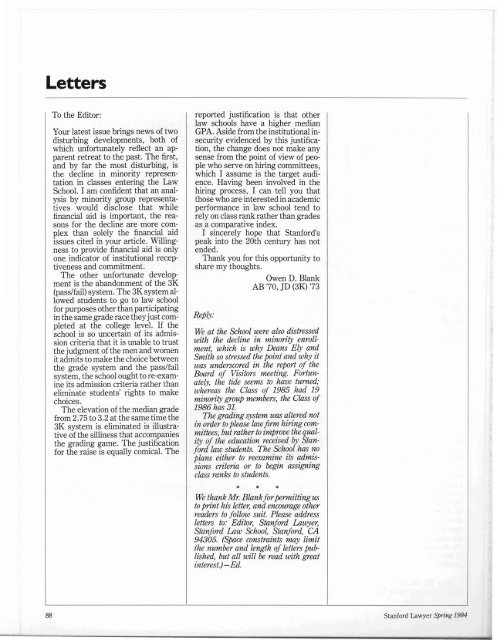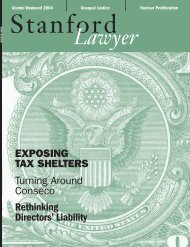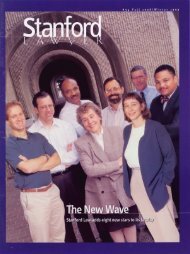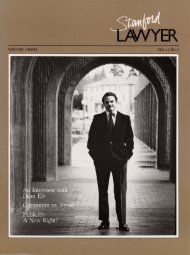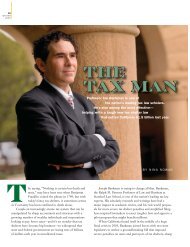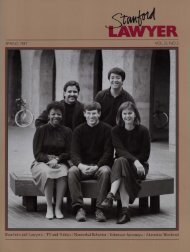Spring 1984 – Issue 31 - Stanford Lawyer - Stanford University
Spring 1984 – Issue 31 - Stanford Lawyer - Stanford University
Spring 1984 – Issue 31 - Stanford Lawyer - Stanford University
- No tags were found...
Create successful ePaper yourself
Turn your PDF publications into a flip-book with our unique Google optimized e-Paper software.
LettersTo the Editor:Your latest issue brings news of twodisturbing developments, both ofwhich unfortunately reflect an apparentretreat to the past. The first,and by far the most disturbing, isthe decline in minority representationin classes entering the LawSchool. I am confident that an analysisby minority group representativeswould disclose that whilefinancial aid is important, the reasonsfor the decline are more complexthan solely the financial aidissues cited in your article. Willingnessto provide financial aid is onlyone indicator of institutional receptivenessand commitment.The other unfortunate developmentis the abandonment of the 3K(pass/fail) system. The 3K system allowedstudents to go to law schoolfor purposes other than participatingin the same grade race they just completedat the college level. If theschool is so uncertain of its admissioncriteria that it is unable to trustthe judgment of the men and womenit admits to make the choice betweenthe grade system and the pass/failsystem, the school ought to re-examineits admission criteria rather thaneliminate students' rights to makechoices.The elevation of the median gradefrom 2.75 to 3.2 at the same time the3K system is eliminated is illustrativeof the silliness that accompaniesthe grading game. The justificationfor the raise is equally comical. Thereported justification is that otherlaw schools have a higher medianGPA. Aside from the institutional insecurityevidenced by this justification,the change does not make anysense from the point of view of peoplewho serve on hiring committees,which I assume is the target audience.Having been involved in thehiring process, I can tell you thatthose who are interested in academicperformance in law school tend torely on class rank rather than gradesas a comparative index.I sincerely hope that <strong>Stanford</strong>'speak into the 20th century has notended.Thank you for this opportunity toshare my thoughts.Owen D. BlankAB '70, JD (3K) '73Reply:We at the School were also distressed .with the decline in minority enrollment,which is why Deans Ely andSmith so stressed the point and why itwas underscored in the report of theBoard of Visitors meeting. Fortunately,the tide seems to have turned;whereas the Class of 1985 had 19minority group members, the Class of1986 has <strong>31</strong>.The grading system was altered notin order to please law firm hiring committees,but rather to improve the qualityof the education received by <strong>Stanford</strong>law students. The School has noplans either to reexamine its admissionscriteria or to begin assigningclass ranks to students.* * *We thank Mr. Blankfor permitting usto print his letter, and encourage otherreaders to follow suit. Please addressletters to: Editor, <strong>Stanford</strong> <strong>Lawyer</strong>,<strong>Stanford</strong> Law School, <strong>Stanford</strong>, CA94305. (Space constraints may limitthe number and length of letters published,but all will be read with greatinterest.) - Ed.88<strong>Stanford</strong> <strong>Lawyer</strong> <strong>Spring</strong> <strong>1984</strong>


